Hamster
Able to run as quickly backwards as forwards!
Advertisement
Hamster Scientific Classification
Read our Complete Guide to Classification of Animals.
Hamster Conservation Status
Hamster Facts
- Average Litter Size
- 8
- Lifestyle
- Solitary
- Favorite Food
- Seeds
- Type
- Mammal
- Slogan
- Able to run as quickly backwards as forwards!
View all of the Hamster images!
Hamsters are small-sized rodents. They are very commonly kept as house pets. However, unlike other rodents, they have short tails.
Their legs are stubby with widely-spaced feet, and their ears are small. Hamsters are found in a variety of colors, using grey, yellow, black, white, brown, golden, and red. They exist in a mixture of several colors. They are usually 2 to 6 inches long and weigh about 6.2 oz on average.
See all of our expert product reviews.
There are several types of hamsters, including dwarf hamsters, golden dwarfs, and Syrian hamsters, which are also known as the teddy bear hamster. They go by the scientific name Cricetinae.
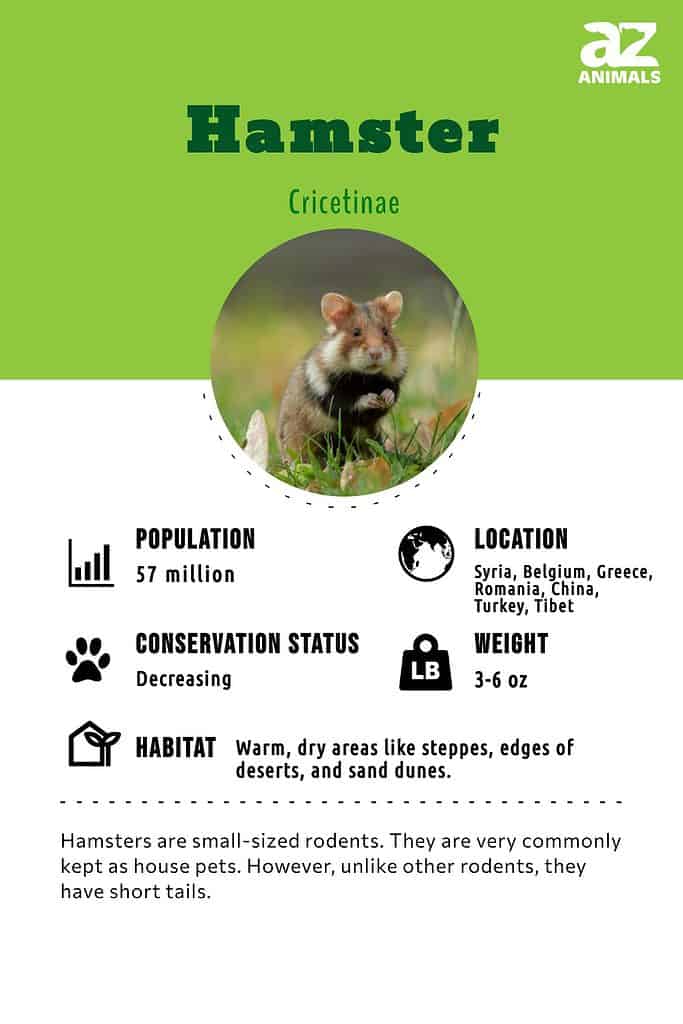
Incredible Hamster Facts!
- Hamsters make good house pets because they are very gentle and are said to take care of. Some common names of pet hamsters include Cheeks, Chomper, Chewy, Harry, and Fuzzy.
- Hamsters bite when they are scared or are disturbed during their sleep time.
- Hamsters have very poor eyesight, and their feet are wide apart.
- Their teeth keep growing all the time and are short only because they keep chewing on things.
- Hamster mothers are very protective and keep their babies in pouches inside their mouths if they sense danger.
Scientific Name
Hamsters go by the scientific name Cricetinae. They belong to the kingdom Animalia and Phylum Chordata, and the class is Mammalia. The hamsters belong to order Rodentia and suborder Myomorpha.
The family is Cricetidae, and the subfamily is Cricetinae. The lower classification of the hamsters includes the subphylum, which is Vertebrata. Meanwhile, the superfamily is Murodiea.
The name Cricetinae can be broken down into two words – cricetus and -inae (a suffix). Cricetus is rooted in New Latin, though it may come from the Czech word “křeček.”
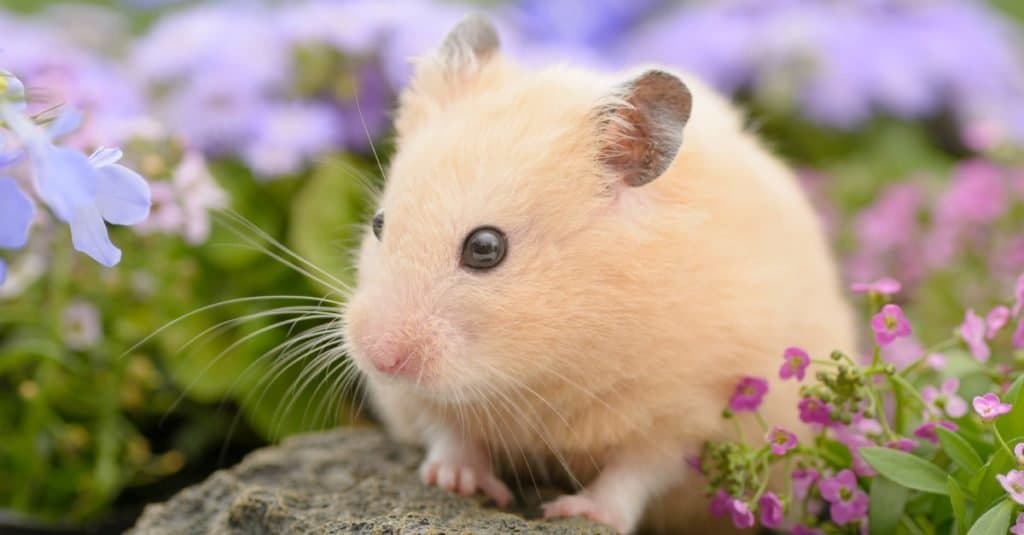
Hamsters go by the
Health and Entertainment for your Hamster
See all of our expert product reviews.
scientific name
Cricetinae.
©stock_shot/Shutterstock.com
Evolution and Origin
The Syrian hamster was first described in 1839, but it wasn’t until 1939 that researchers were able to successfully domesticate them. The entire population of Syrian hamsters is believed to be descendants of a single brother-sister pair captured from Aleppo, Syria, in 1930.
After being imported to Jerusalem, they bred very successfully. Later, some animals from this original breeding colony were exported to the United States, where they quickly became popular as pets and laboratory animals. Comparative studies between wild and domesticated Syrian hamsters have revealed reduced genetic variability within the domestic strain. However, any differences found remain relatively small when compared with other variations seen in other lab animals.
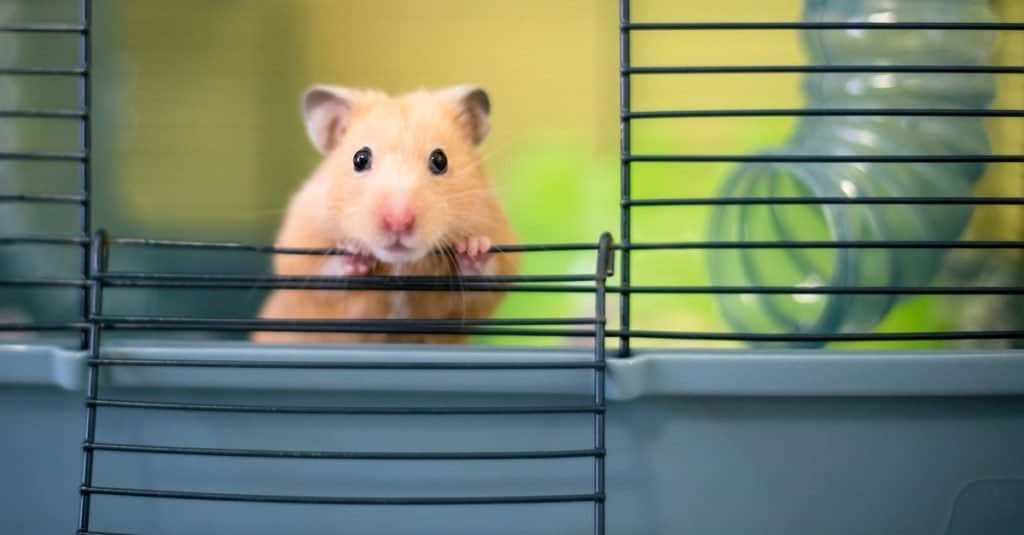
The entire population of Syrian hamsters is believed to be descendants of a single brother-sister pair captured from Aleppo, Syria, in 1930.
©Mary Swift/Shutterstock.com
Appearance
Hamsters are small rodents that have stout bodies. Their legs are stubby and stocky legs, and their ears are small. Hamsters have short tails that are even shorter than the length of their bodies. Their ears are furry, and their feet are wide.
Though most species have fairly similar bodies, each one has identifying markings and sizes that determine which species they are. The dwarf hamster, much like their name, is a very tiny rodent. They are about 2 to 4 inches long.
On the other hand, the Syrian hamster is quite different. It is also referred to as a teddy bear hamster or golden hamster, growing to approximately 6 inches long as an adult. On average, a hamster weighs about 6.2 ounces, making it rather small with very little muscle.
In general, hamsters have thick and silky fur, and it could be long or short, depending on the hamster. This fur comes in a variety of colors, including black, grey, yellow, red, brown, and white. Some hamsters also have fur that is a blend of several different colors, but the combination will be determined by the breed.
These rodents have a scent gland that is located in the middle of their bodies. In the case of a dwarf hamster, the scent gland is located in the hamster’s stomach, allowing them to mark their territory. However, the Syrian hamster (aka the teddy bear hamster) has scent glands on their hips instead.
Interestingly, hamsters have a natural way to get out of trouble when they need to escape – their skeletons. The flexibility of their rib cage allows them to flatten their body under small crevices. Anyone that owns such a pet will need to have a secure cage to keep them from escaping.
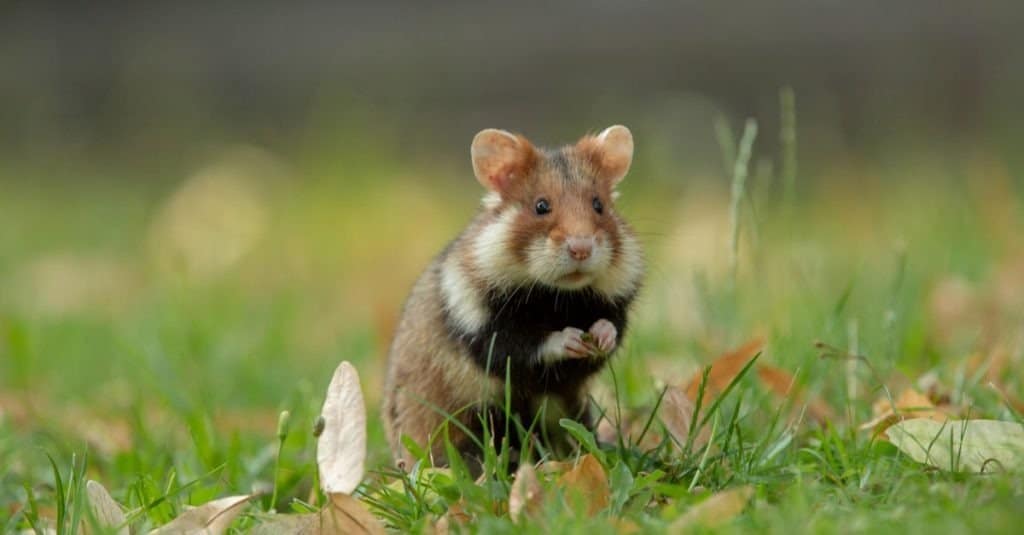
Hamsters are small rodents that have stout bodies. Their legs are stubby and stocky legs, and their ears are small.
©An13nA/Shutterstock.com
Behavior
Most wild hamsters are active during dusk time and night and need plenty of space to play at night time. Some of them can easily run up to 5 miles during this time. When hamsters are kept as pets, they maintain this natural routine.
Their waking hours take up the nighttime, whether in the wild or in captivity, which means that they are awake during the night. They prefer to be undisturbed, so wild hamsters will avoid other wildlife and people during this time. Any unwarranted disturbance in their sleep could very well lead to a bite from these tiny rodents.
They survive best in rooms where the lights are not kept on till very late. In the wild, many hamsters dig burrows, and several others are solitary creatures, which is why they need plenty of areas to conceal themselves. Wild hamsters hibernate during the cold weather months. These rodents get up during their hibernation periods only to eat occasionally.
A loner hamster, it is said, should never be put in a cage with other hamsters as it can bite and harm it and, in some cases, even kill it. The only time that these animals are especially friendly towards other hamsters is when they are young (i.e., under three months old). They will even eat their young if they so desire.
The dwarf hamster is an exception. They are surprisingly social, and they enjoy having multiple friends around in their family.
In captivity, hamsters can sometimes flinch, grimace, and raises its hand toward their owners. This simple motion is an indication that the hamster may be ready to attack, showing exactly how they feel about the person infiltrating their safe space.
If a human earns the trust of a hamster as a pet, the animal will gently move towards their hand and even crawl into it. They are fairly expressive animals, and there is no doubt about how they feel about their owner or surrounding animals.
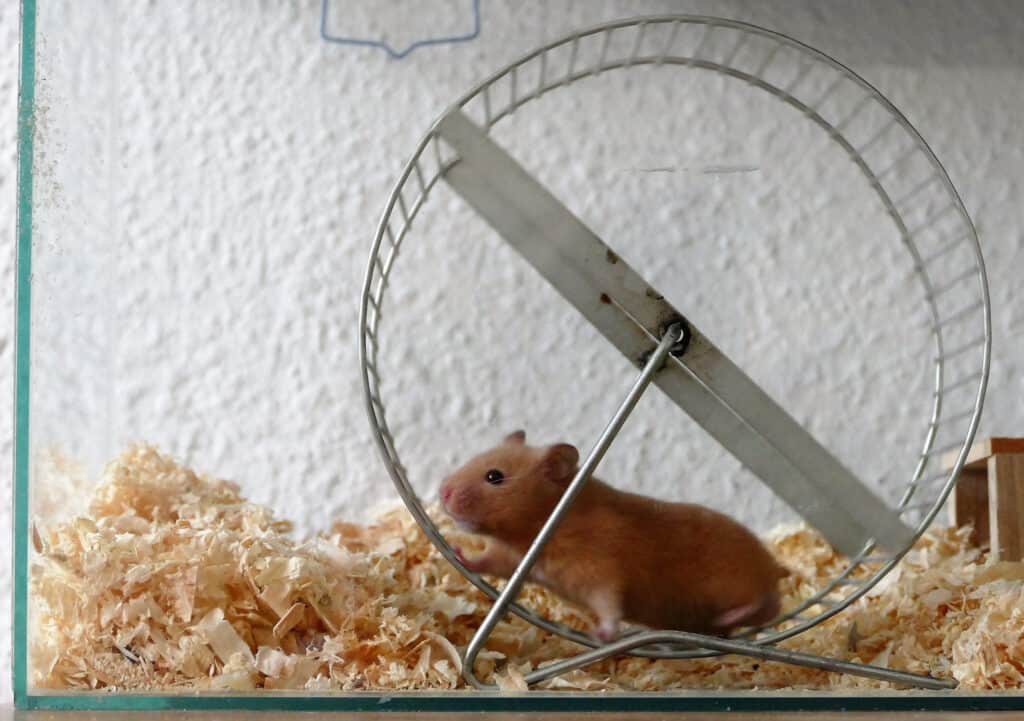
In the wild, hamsters can run 5 miles per night. An exercise wheel is essential, whether your hamster gets time out of its cage or not.
©Katinka Bakos/Shutterstock.com
Habitat
The first of these small rodents was found in Syria. However, they are also found in Belgium, northern China, Romania, and Greece. In the wild, hamsters prefer living in warm and dry areas. They like living in steppes, edges of deserts, and sand dunes.
Hamsters have also become an incredibly popular pet, and there are many toys and hideaways that can be added to their home to recreate their natural surroundings.
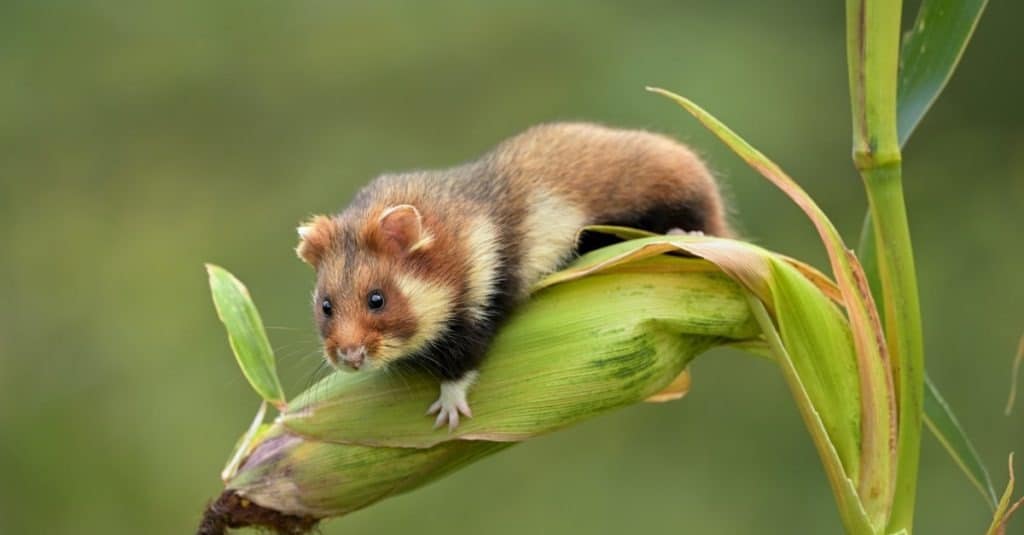
In the wild, hamsters live in steppes, edges of deserts, and sand dunes
©Lubomir Novak/Shutterstock.com
Diet
The primary diet of Hamsters includes seeds, nuts, grains, fruits, vegetables, and cracked corn. Apart from that, hamsters also eat small insects, lizards, as well as other small animals.
Interestingly, hamsters have pouches on the inside of their cheeks, and they carry food in these pouches to store and eat later.

Predators and Threats
Hamsters are known to defend themselves against these predators by using their incisors which are large in size. The mother hamsters also carry their children to safety by putting them in the pouches in their mouths.
The predators of this small animal are numerous since they are small and easy to pick up. However, they are quite fast and spritely.
What Eats Hamsters?
The common predators of hamsters include snakes, birds, and other predatory mammals. That doesn’t mean that a hamster won’t put up a good fight. Instead, they use their naturally long incisors to bite. If the hamster is a new mother, she will keep her young safe within her mouth’s pouches.
Interestingly, the most likely cause of death in hamsters isn’t being hunted – it is heart disease.
What Do Hamsters Eat?
Hamsters, in turn, feed on seeds, grains, fruits, nuts, cracked corn, small insects, lizards, and other animals. They are herbivores, so they do not seek out any other animal as prey.
These animals should never eat kidney beans, tomato leaves, or unwashed produce. All of these sources of nutrients are incredibly toxic.

The most common predators of hamsters are snakes and birds.
©iStock.com/hikaru1222
Reproduction, Babies, and Lifespan
Both male and female hamsters are known to be fast maters. They are known to waste no time in the process of reproduction, and it is often said that if hamsters from two separate genders are locked in a cage, the female can very quickly conceive.
The gestation period in hamsters is about 15 to 20 days. A group of hamster babies, known as a litter, is born shortly after. The average litter size is six to eight pups. The hamster babies are blind till about two weeks after their birth. They have to be weaned when they are about three to four weeks old. However, these animals should be watched carefully, as they are one of many animals that may eat their young.
It is said that female hamsters give birth to two to three litters of hamster babies annually. The lifespan of these small rodents is about one to two years. In captivity, they can survive up to three years.
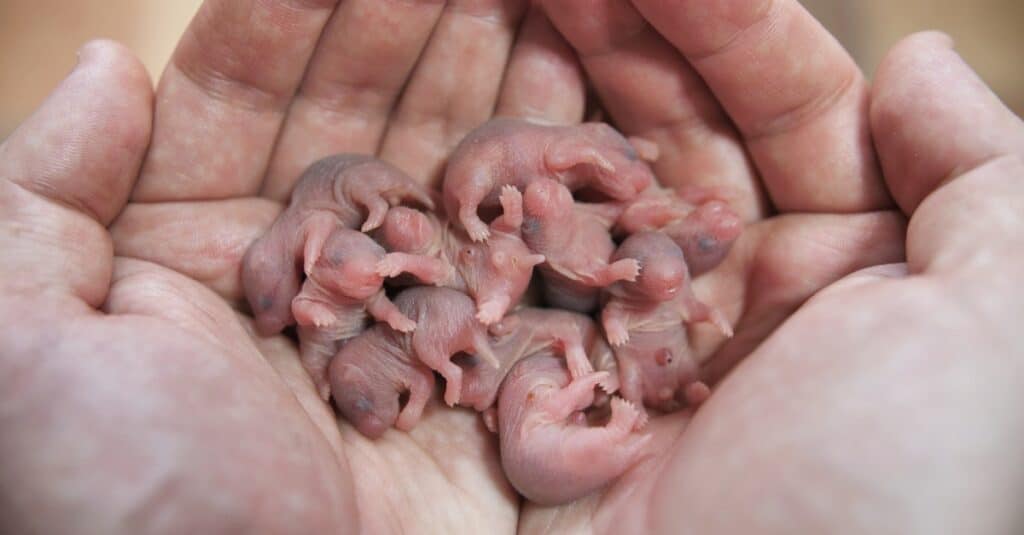
Hamsters have an average of six to eight pups per litter and can mate two or three times per year.
©iStock.com/Mikhail Davidovich
Hamsters vs. Mice
When comparing a hamster vs. a mouse, hamsters are generally larger than mice. In addition, hamsters generally are found in a wider variety of colors than mice. Mice are also more opportunistic eaters, while hamsters are known to hoard food and even store it in their mouths.
Hamsters vs. Guinea Pigs
Another popular pet rodent that hamsters are often compared with is guinea pigs. Guinea pigs are generally larger than hamsters and weigh several pounds, whereas hamsters weigh less than a pound. In addition, hamsters are omnivores, while guinea pigs are strict herbivores.
Population
While it is not known how many hamsters live in the wild all over the world, it has been said that the pet population of hamsters is around 57 million. About 11 million households have hamsters as pets.
Hamsters in the Zoo
Little is known about hamsters living in zoos. However, it is said that they multiply quickly and find their way into parks, universities, and zoos. For anyone that wants to learn more about hamsters in an up-close way, most pet stores will carry at least a few different species.
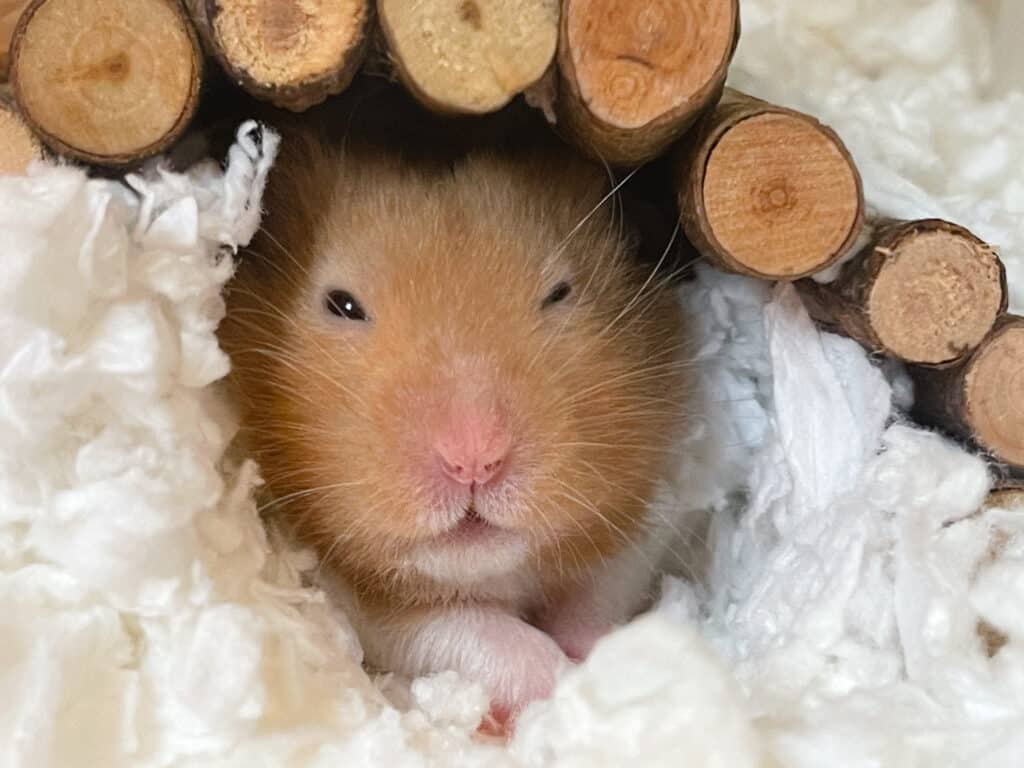
The population of pet hamsters is approximately 57 million. The wild population is unknown.
©iStock.com/Conny V
The 19 Types of Hamsters
The subfamily Cricetinae contains 19 different species of hamsters from different geographical regions. Of these hamsters, many are never kept as pets. The five most commonly-kept types of hamsters for pet owners are Syrian hamsters, Campell’s dwarf hamsters, Roborovski dwarf hamsters, winter white dwarf hamsters, and Chinese hamsters.
- Syrian Hamster – Syrian hamsters are a common type of hamster kept as a pet. They can grow up to 6 inches long and are usually golden brown with darker markings around their cheeks. Syrian hamsters tend to be more solitary, so they should be kept to one in a cage. They can get along well with pet owners if proper interaction and entertainment are provided.
- Campbell’s Dwarf Hamster – One of only two species of Russian dwarf hamsters, the Campbell’s Dwarf hamster is a very common pet store find. They were named after Charles William Campbell, who first caught one in Mongolia in 1904. They come in many colors and are friendly, boisterous, and active. Campbell’s Dwarf hamsters can become territorial if kept in groups. This means they should be kept in very large enclosures. Additionally, this species is genetically predisposed to developing diabetes.
- Roborovski Dwarf Hamster – The Roborovski hamster is a small, energetic, and wild hamster species that originates from central Asia’s deserts. They have become popular pets recently due to their fun temperament and tiny size. These hamsters only reach an average length of 2 inches. Still, their fluffy fur comes in various colors, making them look extremely cute. Although they make great pets to observe, they require a large cage and many different toys.
- Winter White Dwarf Hamster – The Winter White Dwarf hamster is similar to the Campbell’s Dwarf hamster but has a different body shape and comes in different colors. They also are more mild-mannered and reserved than Campbell’s hamsters. The name “Winter White Dwarf hamster” comes from the fact that these hamsters’ fur usually turns white in the winter to camouflage themselves from predators. Winter white dwarf hamsters can cross-breed with Campbell’s hamsters, so it can be difficult to find a purebred Winter white dwarf hamster.
- Chinese Hamster – The Chinese hamster is a small, energetic hamster that can be difficult to handle. These hamsters require large enclosures with plenty of space to run around. Several states have labeled them pests, so special permits are required.
- Chinese Striped Hamster – The Chinese Striped hamster is a species of hamster that is native to central and eastern Asia. These hamsters live in long burrows and emerge to forage for food at night. They have an average body length of 3.9 inches and are mostly light greyish-brown with a faint stripe on the spine.
- Ciscaucasian Hamster – The Ciscaucasian hamster is a large hamster that is found in Georgia and Russia. It has a brown or slightly yellow coloration with a white throat and black underside. It also has very large, rounded ears. This hamster is considered a pest as it likes to steal crops.
- European Hamster – The European hamster is a type of hamster native to a large area in Eurasia. It is considered an agricultural pest and is often hunted for its fur. While it is not considered endangered globally, it is critically endangered in many countries. European hamsters are crepuscular and eat mostly plant matter, like seeds, legumes, grasses, vegetables, and insects. They are often solitary.
- Eversmann’s Hamster – Eversmann’s hamster is a species of hamster that is native to Kazakhstan. It is named after the Russian naturalist, zoologist, and explorer Eduard Friedrich Eversmann. Eversmann’s hamster is part of the family Cricetidae, which is the second-largest family of mammals.
- Gansu Hamster – The Gansu hamster is an endangered species of rodent native to China, easily identified by its small size, round head, short legs, large ears, and long tail. It inhabits grasslands up to two miles above sea level and feeds on seeds and roots. As the only member of its genus (Cansumys), it is often referred to as “the lone hamster.”
- Greater Long-Tailed Hamster – The Greater Long-Tailed hamster is a hamster species in Northern China. It has been considered a major pest in China since ancient times because it eats crops all year round. The hamster also often stands up on its hind legs and screams loudly as a way of communicating with others.
- Grey Dwarf Hamster – The Grey Dwarf hamster is a common hamster species found in Eastern Europe, the Middle East, Russia, Central Asia, Mongolia, and western China. These hamsters have an average body length of 4 inches, with a furry tail about 1/3 of that length. Their fur is brownish-grey with white underparts, and they have large ears and a flattened skull. Grey Dwarf hamsters are known for their burrows, which can be as deep as 5 feet beneath the ground. These hamsters do not hibernate, so they are active year-round as they forage for roots, plants, seeds, and insects.
- Kam Dwarf Hamster – The Kam Dwarf hamster is a hamster species found only in the mountains of western China. These hamsters have an average body length of 4 inches and a tail length of 2 inches. Their fur is greyish-brown in color, and their underside is greyish-white. These hamsters are active day and night and dig burrows to an average depth. They forage for grain and seeds, and they also hunt insects.
- Long-Tailed Dwarf Hamster – The Long-Tailed Dwarf Hamster is a hamster species found in Mongolia, China, Kazakhstan, and Russia. It has an average body length of about 4 inches, with a tail at least 1/3 of that length. It is sandy brown in color on its back, with a greyish-white belly. This hamster lives in dry, arid areas with dry forests, rocky steppes, and shrubby slopes. It is especially common in piedmont semidesert. It is nocturnal and feeds on seeds and insects.
- Mongolian Hamster – The Mongolian hamster is a type of hamster that is found in China and Mongolia. It is relatively muted, with a sandy brownish-grey top coloring and light grey underside coloring.
- Romanian Hamster – The Romanian hamster is a species of hamster found in both Bulgaria and Romania. It is brown with a white underside and a black stripe that runs from its head to its neck. It is around 7 inches long and is nocturnal. It lives solitarily in burrows, where it stores and eats seeds, vegetables, grasses, legumes, and insects.
- Sokolov’s Dwarf Hamster – This type of hamster is usually grey, with a light brown or yellow hue and a dark stripe running down its body. It has a body length of about 3.7 inches and a 1-inch tail. It is found in China and Mongolia, where it lives in underground burrows beneath desert shrubs.
- Tibetan Dwarf Hamster – The Tibetan Dwarf hamster is a species of hamster that is found in Tibet, as well as India, Nepal, and China. It prefers to live in mountainous regions and can be found in altitudes of up to 17,100 feet. This hamster lives in desert steppes, scrublands, swampy grasslands, and Alpine meadows. It has a body about 4 inches long, with a tail of 1.5 inches.
- Turkish Hamster – The Turkish hamster originates in Turkey, Armenia, and several other surrounding nations. It is closely related to the Syrian hamster but is not as well known and rarely kept as a pet. The Turkish hamster population is decreasing in the wild. However, they are often still used as lab test species. These extremely adaptable hamsters live in sand dunes, scrublands, and desert steppes. These areas are very dry with little plant matter, so the hamsters burrow 6 feet under the ground for shelter.
Hamster FAQs (Frequently Asked Questions)
Are hamsters carnivores, herbivores, or omnivores?
Hamsters are omnivorous in nature. They eat seeds, grains, fruits, cracked corn, and vegetables. They also feed on Lizards, small insects, and small animals.
How much does a hamster cost?
Hamsters cost only about $15 to $20.
Are hamsters a good pet?
Hamsters make great family pets as they are low maintenance and are fun to play with.
Do hamsters bite?
Hamsters bite when they are scared and when their sleep is interrupted.
How long do hamsters live?
The lifespan of hamsters is about one to two years but in captivity, they can survive up to three years.
How big do hamsters get?
The dwarf hamster, much like their name, is a very tiny rodent. They are about 2 to 4 inches long.
Meanwhile, the Syrian hamster which is also known as the teddy bear hamster or golden hamster usually grows to about 6 inches (15.24 cm) long.
A hamster, on average, weighs around 6.2 oz.
What are some of the types of hamsters?
Some types of hamsters are dwarf hamster, Syrian hamster or the teddy bear hamster, and the golden hamster.
What is the lower classification of hamsters?
The lower classification of the hamsters includes the subphylum which is Vertebrata. Meanwhile, the superfamily is Muroidea.
What are some of the popular names for hamsters?
Some popular names for hamsters are Cheeks, Chomper, Chewy, Harry, and Fuzzy.
What Kingdom do Hamsters belong to?
Hamsters belong to the Kingdom Animalia.
What phylum do Hamsters belong to?
Hamsters belong to phylum Chordata.
What class do Hamsters belong to?
Hamsters belong to the class Mammalia.
What family do Hamsters belong to?
Hamsters belong to the family Cricetidae.
What order to Hamsters belong to?
Hamsters belong to order Rodentia.
What type of covering do Hamsters have?
Hamsters are covered in Fur.
In what type of habitat do Hamsters live?
Hamsters live in dry deserts and sand dunes.
What are some predators of Hamsters?
Predators of Hamsters include owls, hawks, and snakes.
What do Hamsters eat?
Hamsters eat seeds, nuts, and berries.
What is the average litter size for a Hamster?
The average litter size for a Hamster is 8.
What is an interesting fact about Hamsters?
Hamsters are able to run as quickly backwards as forwards!
How fast is a Hamster?
A Hamster can travel at speeds of up to 4 miles per hour.
What's the difference between a rat and a hamster?
There are many differences between a rat and a hamster. Rats have much longer tails compared to hamsters, and hamsters are less social than rats, both in captivity and in the wild.
What are the differences between lemmings and hamsters?
The main differences between a lemming and a hamster are where they live, their appearance, and their relationship with humans.
Thank you for reading! Have some feedback for us? Contact the AZ Animals editorial team.
Sources
- Live Science, Available here: https://www.livescience.com/27169-hamsters.html
- Wikipedia, Available here: https://en.wikipedia.org/wiki/Hamster
- RSPCA, Available here: https://www.rspca.org.uk/adviceandwelfare/pets/rodents/hamsters/behaviour
- Sciencing, Available here: https://sciencing.com/animals-commonly-eat-hamsters-wild-8467984.html
- PFMA, Available here: https://www.pfma.org.uk/hamsters

















